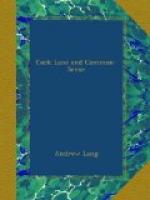On the other hand Miss X. can trace many of her visions to memories, as Maury could in his illusions hypnagogiques. Thus, Miss X. saw in the crystal, the printed announcement of a friend’s death. She had not consciously read the Times, but remembered that she had held it up before her face as a firescreen. This kind of revival, as she says, corresponds to the writing, with planchette, of scraps from the Chanson de Roland, by a person who had never consciously read a line of it, and who did not even know what stratum of Old French was represented by the fragments. Miss X. seems not to know either; for she calls it ‘Provencal’. Similar instances of memory revived are not very uncommon in dreams. Miss X. can consciously put a group of fanciful characters into the crystal, while this is beyond the power of the seer known to the writer, who has attempted to perceive what a friend is doing at a distance, but with no success. Thus she tried to discover what the writer might be about, and secured a view of two large sunny rooms, with a shadowy figure therein. Now it is very probable that the writer was in just such a room, at —– Castle, but the seer saw, on the library table, a singular mirror, which did not exist there, and a model of a castle, also non-existent. The knowledge that the person sought for was staying at a ‘castle,’ may have unconsciously suggested this model in the picture.
A pretty case of revived memory is given by Miss X. She wanted the date of Ptolemy Philadelphus. Later, in the crystal, she saw a conventional old Jew, writing in a book with massive clasps. Using a magnifying glass, she found that he was writing Greek, but the lines faded, and she only saw the Roman numerals LXX. These suggested the seventy Hebrews who wrote the Septuagint, with the date, 277 B.C., which served for Ptolemy Philadelphus. Miss X. later remembered a memoria technica which she had once learned, with the clue, ‘Now Jewish elders indite a Greek copy’. It is obvious that these queer symbolical reawakenings of memory explain much of the (apparently) ‘unknown’ information given by ‘ghosts,’ and in dreams. A lady, who had long been in very bad health, was one evening seized by a violent recrudescence of memory, and for hours poured out the minutest details of the most trivial occurrences; the attack was followed by a cerebral malady from which she fortunately recovered. The same phenomenon of awakened memory has occasionally been reported by people who were with difficulty restored after being seven-eighths drowned.
The crystal ball, in the proper hands, merely illustrates the possibility of artificially reviving memory, while the fanciful visions, akin to illusions hypnagogiques, have, in all ages, been interpreted by superstition as revelations of the distant or the future. Of course, if there is such a thing as occasional transference of thought, so that the idea in the inquirer’s mind is reflected in the crystal-gazer’s vision,




